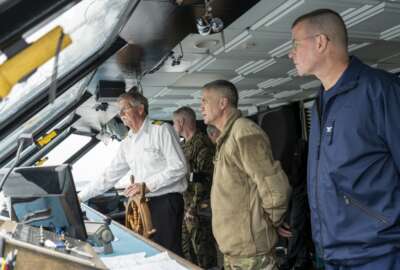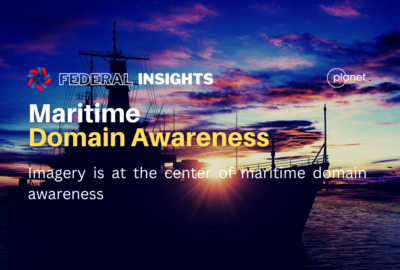DoD moves to improve maritime security in contested Southeast Asia
A new industry and government consortium has joined the federal scene. This one is devoted to maritime security in Southeast Asia, or MARSEC.
A new industry and government consortium has joined the federal scene. This one is devoted to maritime security in Southeast Asia, or MARSEC. Secretary of Defense for South and Southeast Asia Laura Updegrove joined the Federal Drive with Tom Temin to discuss who’s in it and what they plan to do.
Interview transcript:
Tom Temin: And tell us what problem or what issue this MARSEC, this consortium, first of all, is driving it.
Laura Updegrove: Sure. Happy to do so. And thank you again for having me on to talk about the Maritime Security Consortium or, as you noted, the MARSEC Consortium, as we call it. It is a really important new initiative we have here at the Pentagon. I’m hoping before jumping into the details on what the consortium actually does, I could take just a step back to paint the broader picture of where this fits in. So over the course of the Biden administration, we have seen a steadfast commitment to working with partners and allies in the Indo-Pacific. And we have made great strides in deepening these relationships in a number of ways by brokering new agreements on information sharing, expanding U.S. force posture in the region, delivering cutting edge technologies to meet our shared security priorities, and working to facilitate new multilateral groupings, including everything from AUKUS to investment in the Quad, which is a partnership between the United States, Australia, India and Japan, and also establishing a series of multilateral maritime cooperative activities in and around the South China Sea. And over the past few years, we have seen a new dynamic emerging in the Indo-Pacific as our allies and partners work together more closely than ever to advance a shared vision, to move forward on principles like respect for sovereignty and international law, free flow of commerce and ideas and freedom of the seas and skies. Just last year in Singapore, Secretary Austin referred to this as the new convergence in the Indo-Pacific. And one of the ways that we are contributing to this new convergence, where more capable militaries in the region can contribute to regional security and where our combined efforts can empower our allies and partners to protect their sovereignty and fully utilize their exclusive economic zones, is by doing more joint activities with more advanced capabilities. And so that’s where the Maritime Security or MARSEC Consortium comes in. It’s a way to ensure that our partners get the capabilities that they need to meet their security requirements. And of course, happy to talk more about what the consortium does today.
Tom Temin: So the way, for example, China keeps interfering with maritime shipping in the Philippines would be an example of the kind of thing you’re trying to counter here?
Laura Updegrove: So the Maritime Security Consortium is first and foremost about what we can achieve with our partners and allies. It’s ensuring that they have the ability to protect their sovereignty and operate fully and freely in their exclusive economic zone and protect their key rights. That being said, it’s no secret that China is behaving in an aggressive, risky and illegal set of behaviors in the South China Sea. It’s something that Secretary Austin has spoken about on a number of occasions and you should certainly take a look at the China military power report that DoD just recently put out. But the MARSEC Consortium, which is a public-private initiative focused on transforming maritime security in Southeast Asia, it is really focused on giving our partners and allies the capabilities they need to defend themselves from a whole range of threats. So you did mention, you know, one thing, but really the capabilities provided through MARSEC are things that our partners can use on a daily basis to protect against illegal incursions, transnational criminal threats and illegal resource exploration, including energy exploitation and overfishing.
Tom Temin: Got it. We’re speaking with Laura Updegrove, who at the time was the deputy assistant secretary of defense for South and Southeast Asia. Who is in the consortium because, I guess, there’s some DoD elements, but who from industry also?
Laura Updegrove: Sure. So the consortium in this moment is really focused on Southeast Asia and maritime domain awareness and security. And so working with our partners in that part of the Indo-Pacific to deliver these types of capabilities. It is also composed of a range of solution providers from the largest defense companies to startups with compelling and innovative perspectives on the application of asymmetric capabilities. Industries and industry partners and investors are invited to participate in the consortium through regular industry engagements with the Defense Innovation Unit, the Office of the Undersecretary of Defense for Policy and through USINDOPACOM. And when we launched this initiative, we did it with the Defense Innovation Unit, DIU, and also with DSCA, the Defense Security Cooperation Agency. So this really is a public-private partnership between government and across DoD, the private sector and our foreign counterparts.
Tom Temin: And what will members do together? What are some of the deliverables that the consortium could end up spinning out?
Laura Updegrove: Sure. So again, the launching of the MARSEC Consortium is really a furthering of the Biden administration’s deep commitment to increasing the capabilities and our shared security picture with partners and allies in the Indo-Pacific and in Southeast Asia. And we only just launched this consortium in November of last year. We’ve had a number of engagements already and we’re looking towards the future of what can be achieved. So in October, we started conversations around a annual engagement that INDOPACOM leads called the Capabilities and Exercise Working Group that brings together security cooperation officers from all of the countries in INDOPACOM and created a dialogue with them on what kind of asymmetric capabilities they may need to meet their security requirements. And then in November, we officially launched the MARSEC Consortium with DIU’s Joint Innovation Lab. And then in December of this year, a senior DoD official led a consortium discussion with U.S. industry and reps from the Vietnam government on the sidelines of the big Vietnam Defense Expo. So that was an important engagement. But we have actually already started delivering the types of capabilities that MARSEC Consortium will focus on. Just last year, we delivered a number of low cost, commercially available unmanned capabilities to the Philippines, one of which was the T12 unmanned surface vessel that you saw Secretary Austin participate in a demonstration of last year during his visit to the Philippines. And looking forward, I would just say that next year we are actually seeking to integrate technology demonstrations of these capabilities into regional exercises, including the Philippines hosted Balochistan and the Indonesian hosted Garuda Shield. We think it’s really important that our partners in the region have the ability to see these technologies in action and better understand requirements. They will be able to meet again to help kind of develop a shared approach to regional security.
Tom Temin: And how far could this go? Like the T12 is unmanned surface vessel. It looks like a little sort of a huge canoe, you might say, with a little pointed prow there. Could that be equipped with kinetic type of capabilities? Could it shoot or is it simply observational at this point.
Laura Updegrove: We’re not talking about those types of kinetic capabilities in this moment. This is really about giving our partners and allies better ability to see and hear the eyes and ears of what’s going on in their exclusive economic zones and for their ability to protect their sovereignty, but also operate together. Interoperability is a big part of this. And over the last several years, we’ve delivered over $400 million in maritime domain awareness type of assistance through investments that Pacific Fleet has made in a system called SeaVision and through other capabilities that they’ve been able to provide to the region that, again, help us all operate together with a shared understanding of what’s going on in areas like the South China Sea.
Tom Temin: And of course, nobody knows what will happen. But was this consortium and its activities made known and explained to the landing teams as the transition happened?
Laura Updegrove: I can’t comment in this moment on some of those transition conversations, but what I can say is that the Biden administration has been working steadfast in investing in what certainly we believe is a shared picture in a bipartisan way of the best interests of U.S. national security. And so there is a ton of bipartisan support for the types of initiatives that we have pursued in supporting partners and allies in the region. And the MARSEC Consortium fits very nicely in that. And so I certainly we are working up until the very last day, as illustrated by the launch of this program just a couple of months ago, ensuring that we continue to move the ball forward so that the next team has a set of really solid relationships and initiatives that are ongoing. And again, the bipartisan support has been quite broad.
Copyright © 2025 Federal News Network. All rights reserved. This website is not intended for users located within the European Economic Area.
Tom Temin is host of the Federal Drive and has been providing insight on federal technology and management issues for more than 30 years.
Follow @tteminWFED







